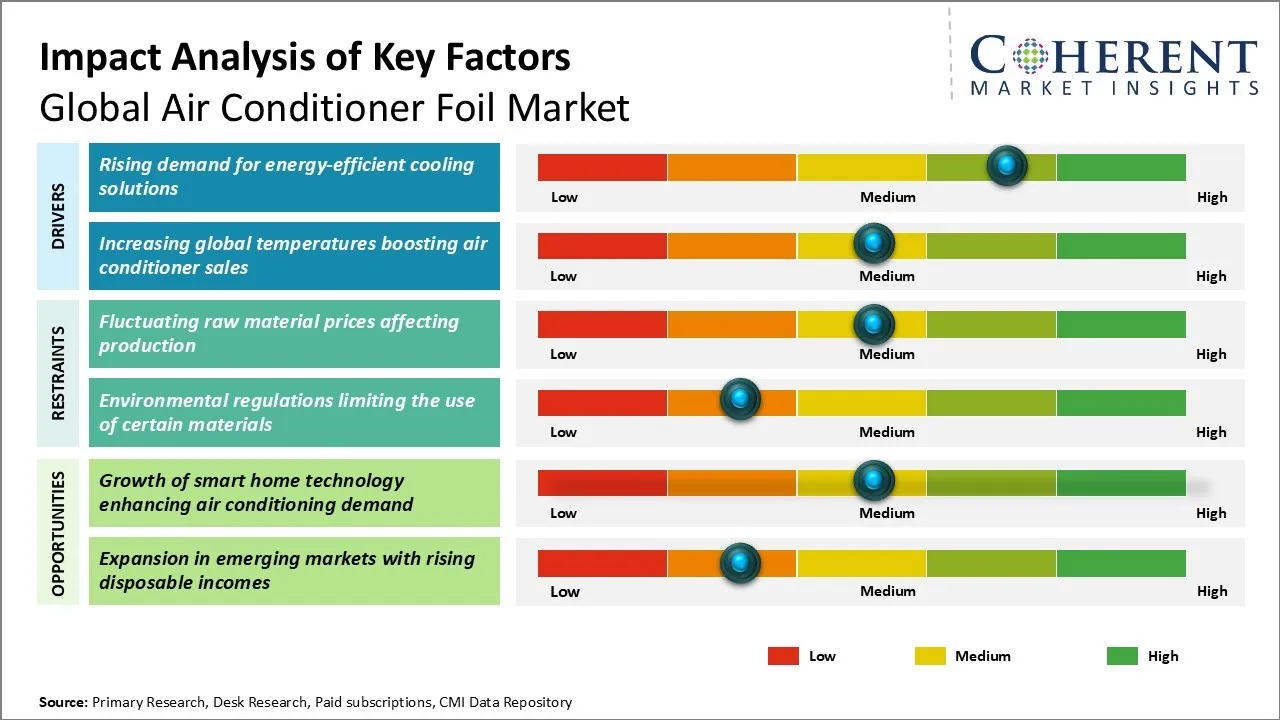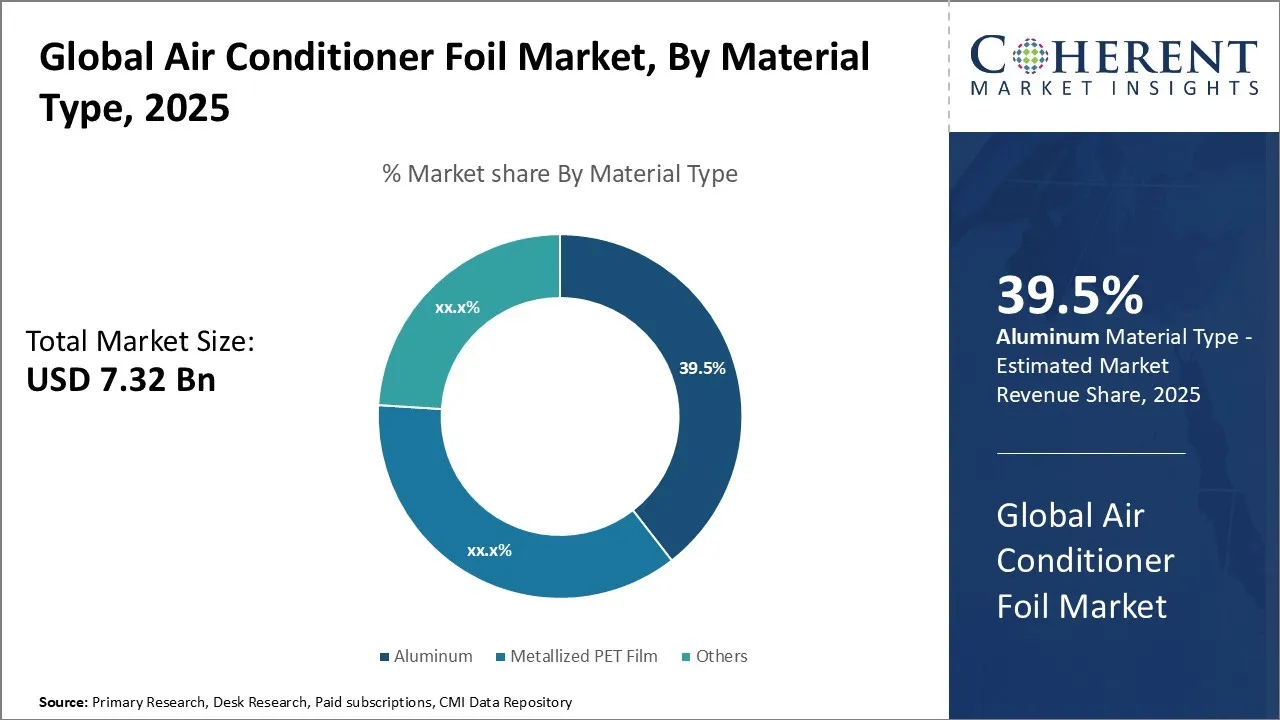Air Conditioner Foil Market Size and Trends – 2025-2032
The global air conditioner foil market is estimated to be valued at USD 7.32 Bn in 2025 and is expected to reach USD 14.45 Bn by 2032, exhibiting a compound annual growth rate (CAGR) of 10.2% from 2025 to 2032.
Key Takeaways of the Air Conditioner Foil Market:
- The aluminum segment is expected to account for 39.5% of the market share by 2025.
- The up to 0.05 mm segment is projected to hold a 38.6% share of the market by 2025.
- The food segment is expected to account for 41.5% of the market share by 2025.
- North America is projected to lead the market with a 41.5% share in 2025, followed by the Middle East region, which is expected to hold a 19.5% share in 2025.
Market Overview:
Key factors, such as rising installation of air conditioners due to increasing global temperatures and changing weather conditions, are driving the demand for air conditioner foils. Furthermore, the growing construction industry especially in Asia Pacific is also supporting the growth of this market. Manufacturers are focusing on developing innovative foils that have better heat reflecting properties and last longer to meet the rising demand. However, availability of substitute products may hinder the market growth.
Material Type Insights - Aluminum's Durability and Barrier Properties Drive its Dominance in the Global Air Conditioner Foil Market
In terms of material type, the aluminum segment is expected to contribute 39.5% share of the market in 2025, owing to its superior durability and barrier properties. Aluminum foil used in air conditioners provides an excellent protective barrier against moisture, oxygen, and other environmental contaminants, helping preserve the quality and extend the shelf life of various products. Its high tensile strength and impermeability allow aluminum foil to withstand the rigors of transportation and shipping. Additionally, aluminum is highly resistant to corrosion and damage from general wear and tear over the lifetime of an air conditioner. The material's lightweight and malleability also make it easy to work with during the manufacturing process.
Thickness Insights - Thinner Foils Dominate Due to Their Space and Weight Savings for Air Conditioner Designs
In terms of thickness, the up to 0.05 mm segment is expected to contribute 38.6% share of the market in 2025. Thinner foils are increasingly preferred by air conditioner manufacturers as they allow for more compact equipment footprints and lighter overall unit weights. The space and weight saved through ultra-thin foils enable equipment designs with smaller ductwork and more streamlined cabinetry. This helps address ongoing demands for higher energy efficiency through better air circulation and heat transfer capabilities. Additionally, regulatory directives relating to reduced environmental impacts have encouraged the use of thinner foils that require less raw material usage during production.
End-use Industry Insights - Food Preservation Drives Robust Demand in Food Applications
In terms of End-use Industry, the food segment is expected to contribute 41.5% share of the market in 2025. Food applications require robust foil barrier properties to preserve freshness and protect nutritional value during storage and transport. The high moisture and gas barrier performance of aluminum foil enables it to effectively package perishable foods like fresh and processed meats, baked goods, cheeses, fruits, and vegetables. Aluminum foil effectively blocks out moisture, oxygen, and other contaminants that can accelerate food spoilage.
Regional Insights

Need a Different Region or Segment? Download Free Sample
North America Air Conditioner Foil Market Trends
North America is expected to dominate the air conditioner foil market, securing a 41.5% market share by 2025. This leadership can be attributed to a robust manufacturing sector, favorable government policies that encourage energy efficiency, and significant consumer investment in smart home appliances. Additionally, key industry players like Symetal have set up production facilities in the region to meet the growing local demand.
Middle East Air Conditioner Foil Market Trends
The Middle East is anticipated to account for 19.5% of the share in 2025. The region is experiencing the fastest growth, driven by a surge in air conditioner installations fueled by rising income levels, expanding construction projects, and the hot climate in countries such as the U.A.E and Saudi Arabia.
Air Conditioner Foil Market Outlook for Key Countries
U.S. Air Conditioner Foil Market Trends
The U.S. is a leading market for air conditioner foils, driven by high penetration rates of air conditioning systems in both residential and commercial sectors. The demand for energy-efficient cooling solutions is a significant trend, with the U.S. Department of Energy promoting initiatives to enhance HVAC efficiency. The market has been growing as manufacturers innovate with advanced foil technologies to meet stringent energy standards.
Germany Air Conditioner Foil Market Trends
Germany's air conditioner foil market has experienced significant growth, driven by stringent energy efficiency regulations and a focus on sustainable building practices. The country's robust construction industry and demand for energy-efficient cooling solutions have further propelled this market. For example, Hydro is a prominent player in the aluminum industry. It has developed advanced air conditioner foils made from low-carbon aluminum.
China Air Conditioner Foil Market Trends
China's air conditioner foil market has experienced significant growth, driven by rapid urbanization, rising disposable incomes, and increased demand for air conditioning in residential and commercial buildings. Harbin Dongxing Aluminum Co., Ltd manufactures aluminum foils, coils, and sheets used in air conditioning heat exchangers. Their products contribute to improved thermal conductivity and energy efficiency in air conditioning systems.
India Air Conditioner Foil Market Trends
India's air conditioner foil market has experienced significant growth, driven by increasing temperatures and rapid urbanization, leading to a heightened demand for affordable and efficient cooling solutions. For example, SunPro Group is one of India's leading manufacturers and exporters. It specializes in aluminum foil for PUR PIR HVAC boards. Their products, such as single-side aluminum vapor control layers and thermal insulation materials, are designed to enhance the efficiency of HVAC systems, aligning with the country's need for cost-effective cooling solutions.
Brazil Air Conditioner Foil Market Trends
Brazil's air conditioner foil market has been experiencing significant growth, driven by the expansion of the construction and automotive sectors, leading to increased demand for energy-efficient air conditioning systems. One notable contributor in this sector is VULKAN do Brasil Ltda., a company with over 40 years of experience in developing and manufacturing power transmission solutions. They specialize in solder-free Lokring tube connection technology, primarily used in refrigeration and air conditioning applications.
Market Players, Key Devlopment, and Competitive Intelligence

Get actionable strategies to beat competition: Download Free Sample
Key Developments:
- In 2023, Novelis announced plans to increase its production capacity for aluminum foil used in air conditioning units. This expansion aims to meet the growing demand for energy-efficient cooling solutions, supporting the company's commitment to sustainability and innovation in the HVAC sector. The investment is expected to enhance Novelis's ability to provide high-performance materials while reducing environmental impact.
- In 2021, Constellium N.V. and UACJ Corporation formed a joint venture to produce aluminum products, including foils for the HVAC industry. This collaboration aims to leverage both companies' technological expertise and market presence, enhancing their ability to meet the growing demand for energy-efficient air conditioning solutions.
Top Strategies Followed by Global Air Conditioner Foil Market Players
- Established Players: Leading companies in the market heavily invest in research and development to innovate new high-performance products. Manufacturers like Hindalco Industries and Jiangsu Dingsheng New Energy Materials Co., Ltd. focus on developing advanced foil materials that are lighter, more durable, and offer improved heat transfer capabilities. Extensive R&D helps them launch cutting-edge products that strengthen brand value in the market.
- Mid-Level Players: Medium-sized players in the market strive to deliver quality yet affordable products. They target price-sensitive consumers by optimizing costs through strategic procurement, vertical integration, and minimizing production overheads. Companies like Hydro and Novelis offer cost-effective foil solutions that provide good value without compromising on features. This allows them to expand market share and compete with industry giants.
- Small-Scale Players: New entrants often target niche customer segments overlooked by larger competitors. They introduce innovative products tailored to specialized application areas like customized foil shapes for specialized evaporator coils. Players like UACJ Foil and Hydralloy focus on unexplored niches and leverage their agility to cater to small customer demands through personalized solutions.
Emerging Startups - Air Conditioner Foil Industry Ecosystem
- Innovative Technologies: Technological advancements are pivotal in enhancing the performance and efficiency of air conditioning systems. Blue Frontier company is developing smart air conditioning systems that adjust the concentration of a salt solution to create cooling with minimal energy requirements. Their technology aims to reduce electricity consumption by more than half compared to conventional systems.
- Sustainable Solutions: Leading manufacturers are producing foils from recycled aluminum, significantly reducing energy consumption and environmental impact. For instance, Novelis utilizes recycled aluminum for over 60% of its production, contributing to a more sustainable supply chain.
Market Report Scope
Air Conditioner Foil Market Report Coverage
| Report Coverage | Details | ||
|---|---|---|---|
| Base Year: | 2024 | Market Size in 2025: | US$ 7.32 Bn |
| Historical Data for: | 2020 To 2024 | Forecast Period: | 2025 To 2032 |
| Forecast Period 2025 to 2032 CAGR: | 10.2% | 2032 Value Projection: | US$ 14.45 Bn |
| Geographies covered: |
|
||
| Segments covered: |
|
||
| Companies covered: |
Henkel, KM Packaging, Bilcare Solutions, Flexifoil Packaging, Alfipa, Hydro, Symetal, Zenith Alluminium Pvt Ltd, OBEIKAN, UACJ Corporation, Norsk Hydro, JW Aluminum, Constellium, Aleris, Hulamin, Elvalhalcor, Gulf Extrusions, Alcoa, Hindalco Novelis, and AMAG Austria Metall AG |
||
| Growth Drivers: |
|
||
| Restraints & Challenges: |
|
||
Uncover macros and micros vetted on 75+ parameters: Get instant access to report
Market Dynamics

Discover market dynamics shaping the industry: Download Free Sample
Air Conditioner Foil Market Growth Factors
Rising demand for energy-efficient cooling solutions
With increasing concerns about global warming and carbon emissions, there is significant emphasis being placed on developing energy-efficient appliances that can lower power consumption. Air conditioners are commonly used across both commercial and residential sectors for cooling needs, but traditionally consume a sizable amount of power during use. As electricity costs continue their upward march globally, homeowners and building owners are recognizing the financial benefits of opting for premium air conditioner foil that enhances efficiency. The inner layer of every air conditioner is composed of foil which plays a vital role in the functioning of the unit. Modern energy-efficient foils featuring nanotechnology are able to reflect up to 97% of radiant heat without any absorption.
Market Challenge - Fluctuating raw material prices affecting production
The global air conditioner foil market is facing significant challenges due to fluctuating prices of key raw materials needed for foil production such as aluminum. Aluminum prices have shown considerable volatility in recent years influenced by geopolitical uncertainties and supply disruptions. As aluminum is the primary raw material used in manufacturing foils for AC units, fluctuations in its prices can have a major impact on production costs for manufacturers. With aluminum accounting for over 60% of total input costs, even small changes in aluminum prices can squeeze profit margins. This makes it difficult for companies to maintain stable production runs and commit to long term supply agreements with OEMs. Unpredictable raw material costs also prevent accurate demand forecasting and capacity planning. The fluctuating costs pose financial risks and introduce inefficiencies in procurement, inventory management and quality control.
Market Opportunity - Growth of smart home technology enhancing air conditioning demand for market
The boom in smart home technologies presents lucrative opportunities for the expansion of the global air conditioning foil market. Modern smart ACs are being integrated with voice control assistants, smart sensors and apps to enable remote monitoring and adjustment of room temperatures. This is allowing end users added levels of convenience and energy savings. As more consumers upgrade to smart home devices, the demand for smart-enabled ACs with communication capabilities is poised to surge tremendously. Manufacturers are developing advanced foils integrated with communication circuits to support WiFi Bluetooth, Zigbee, and other connectivity protocols. The ability to control smart ACs using virtual assistants and smartphones is boosting their desirability over conventional units.
Analyst Opinion (Expert Opinion)
- The global air conditioner foil market is expected to witness steady growth over the forecast period due to rising sales of air conditioners worldwide supported by growing disposable incomes and warming climate. North America dominates the market currently due to the strong presence of HVAC manufacturing units and rising construction activities in residential and commercial sectors within the region. Europe will continue to present lucrative opportunities for market participants however their growth will remain moderate.
- On the technology front, manufacturers are likely to focus on developing more energy efficient foils to help reduce operating costs for consumers without compromising on noise insulation and heat shielding properties. Foil thickness and composition will remain key differentiating factors.
- Rising raw material prices remain a major challenge for manufacturers due to volatile commodity markets. However, development of recycling systems can help offset this restraint to some extent over the coming years. With replacement demand from aftermarket sales also rising, foils makers should target product innovations for replacement applications.
Market Segmentation
- Material Type Insights (Revenue, USD Bn, 2020 - 2032)
-
- Aluminum
- Metallized PET Film
- Others
- Thickness Insights (Revenue, USD Bn, 2020 - 2032)
-
- Up to 0.05 mm
- 05 to 0.1 mm
- Above 0.1 mm
- End-use Industry Insights (Revenue, USD Bn, 2020 - 2032)
-
- Food
- Pharmaceuticals
- Personal Care & Cosmetics
- Others
- Product Type Insights (Revenue, USD Bn, 2020 - 2032)
-
- Printed
- Unprinted
- Application Insights (Revenue, USD Bn, 2020 - 2032)
-
- Wraps
- Bags & Pouches
- Lids
- Laminates
- Others
- Regional Insights (Revenue, USD Bn, 2020 - 2032)
- North America
- U.S.
- Canada
- Latin America
- Brazil
- Argentina
- Mexico
- Rest of Latin America
- Europe
- Germany
- U.K.
- Spain
- France
- Italy
- Russia
- Rest of Europe
- Asia Pacific
- China
- India
- Japan
- Australia
- South Korea
- ASEAN
- Rest of Asia Pacific
- Middle East
- GCC Countries
- Israel
- Rest of Middle East
- Africa
- South Africa
- North Africa
- Central Africa
- North America
- Key Players Insights
- Henkel
- KM Packaging
- Bilcare Solutions
- Flexifoil Packaging
- Alfipa
- Hydro
- Symetal
- Zenith Alluminium Pvt Ltd
- OBEIKAN
- UACJ Corporation
- Norsk Hydro
- JW Aluminum
- Constellium
- Aleris
- Hulamin
- Elvalhalcor
- Gulf Extrusions
- Alcoa
- Hindalco Novelis
- AMAG Austria Metall AG
Share
Share
About Author
Yash Doshi is a Senior Management Consultant. He has 12+ years of experience in conducting research and handling consulting projects across verticals in APAC, EMEA, and the Americas.
He brings strong acumen in helping chemical companies navigate complex challenges and identify growth opportunities. He has deep expertise across the chemicals value chain, including commodity, specialty and fine chemicals, plastics and polymers, and petrochemicals. Yash is a sought-after speaker at industry conferences and contributes to various publications on topics related commodity, specialty and fine chemicals, plastics and polymers, and petrochemicals.
Missing comfort of reading report in your local language? Find your preferred language :
Transform your Strategy with Exclusive Trending Reports :
Frequently Asked Questions
EXISTING CLIENTELE
Joining thousands of companies around the world committed to making the Excellent Business Solutions.
View All Our Clients

